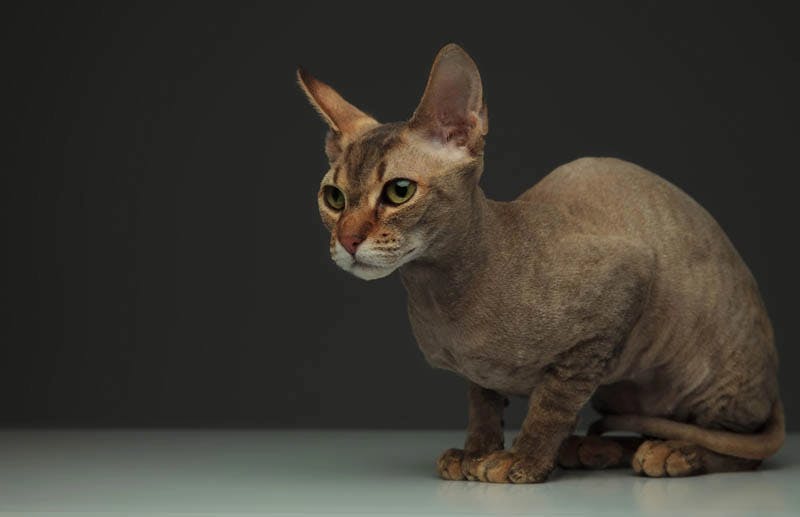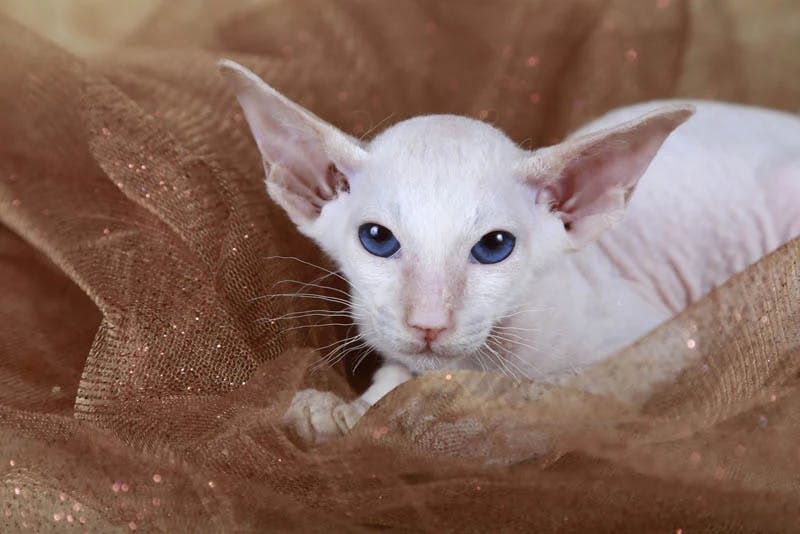Peterbald
A Hairless Breed of Cat with a Heart of Pure Gold
Peterbald
Antonia Cirjak - Last updated on December 18th, 2021
Things you Should Know about the Peterbald
The Peterbald cat is a mixed breed, a cross between the Donskoy and Oriental Shorthair breeds. These cats are best known for their loyal, affectionate, and outgoing personalities.
The “Peter” in their name comes from Saint Petersburg and the “bald” because their coats are mostly hairless. However, you should be aware that these cats require a lot of maintenance as a sensitive hairless breed.
The Peterbald is a wonderful cat with a reputation for being extremely loyal to its human companions. This cat breed will want to spend as much time with you and your family as possible.

Appearance Matters. What does a Peterbald look like?
The Peterbald is small to medium-sized cat. The breed shares some characteristics with the Don Sphynx. These include the varying amount of hair, wrinkly skin, and dexterous front paws.
This is an elegant breed with a long, small body type and an oblong head shape passed on from the Oriental Shorthair.
A unique feature of the Peterbalds is their long front toes that have webbing. This allows them to hold and manipulate various items more quickly.
Peterbald Cat Coats
The coat of Peterbald kittens might not represent how it will look once they are grown.
Throughout the first two years of life, their coat can change significantly. They can gain, alter, or lose the texture of their coat.
Peterbald cats can have five different coats. First, they may be completely hairless. Next, they could have a coat reminiscent of peach or suede leather. The third possible coat is of varying lengths made of soft downy hair with no waves or curls.
The fourth coat a Peterbald can have is also of varying lengths but made of wiry, kinky guard hair. Finally, these cats can have a regular, ordinary cat coat. If they don’t have an altered coat, Peterbalds are called straight coats. As such, they can’t compete for championship titles.
Sometimes, but extremely rarely, bicolored Peterbalds can have a unique trait. The white part of their coat will be made of soft downy hair and the darker part of wiry guard hair.
There will be a sharp demarcation between the two hair types. Peterbald’s whiskers are also often altered and can appear as curled, vestigial, or crinkled.
What colors do the Peterbald cats come in?
These cats can come in a wide variety of colors and patterns. They can have short hair, fine peach fuzz, or no hair. This can completely change during the lifetime of a Peterbald cat.
These the colors that have been the most popular with owners so far:
- White
- Blue
- Black
- Fawn
- Cream
- Platinum
- Apricot
- Caramel
What is the difference between a Peterbald and a Sphynx cat?
Peterbald cats and Sphynx cats both differ greatly from their fellow felines. Despite sharing the hairlessness, the breeds do have a few differences.
Peterbalds usually have longer heads, lower ears, and almond-shaped eyes. Sphynx have broken or no whiskers, while Peterbalds have a mustache.
Peterbald cats have five coat layers and possess a dominant hair gene, while the Sphynx is entirely hairless and has a recessive gene.
It's all Personal. The Peterbald Temperament
The Peterbald is a smart and independent breed. These cats will form strong bonds with their family members. This includes other cats and even friendly dogs.
Many consider these energetic cats to be somewhat “dog-like” in their behavior. This means that they are affectionate and cuddly while also wanting to be involved in day-to-day activities.
Peterbald cats are highly intelligent and can learn various tricks. Similar to dogs, they will use their voices quite a bit to communicate with their owners. These cats are active and highly athletic, and they love spending their time playing with their owners.
You can expect them always to be willing to participate in games or puzzle toys.
The Peterbald will be a great pet for families with young children. You should just make sure that the cat gets socialized early with the kids. You should also set boundaries on both sides and supervise their early interactions.
You should always supervise their playtime with children. The lack of fur means that they are especially vulnerable to injury.
If you have any other pets, you can expect the Peterbald cat to get along with them nicely. This cat enjoys the company of most domestic animals. Still, you should always be present for early interactions.

Caring for your Peterbald
In general, the Peterbald cat is considered a low-maintenance cat breed. You will need to adjust the level of care to the hair type of your cat. This can vary greatly in Peterbalds.
Still, you won’t need to worry about shedding, but you should bathe them weekly. This should be done even with hairless varieties.
You should be careful when bathing them since oils can build up and cause skin irritation. Peterbalds will also need to remain indoor cats. This is because their lack of hair causes them to get cold very easily, which can lead to various problems.
While many believe that Peterbald cats are hypoallergenic, this isn't true. A variety of irritants can stimulate an allergic reaction. It has nothing to do with hair.
These irritants include provocations from cat saliva, skin dander, or hair.

The Health and Happiness of your Peterbald
The lifespan of a Peterbald is similar to many other cat breeds. If you take care of them properly, these cats can live anywhere from 12 to 15 years.
This is a sensitive breed when it comes to weather changes and potential injuries to their thin skin.
Injury can happen when they are playing with a cat companion or running around the house with children. Other than that, these cats are not associated with any breed-related severe health issues.
Where Can You Find Reputable Peterbald Breeders?
Despite being amazing pets, these cats are quite hard to come by. If you want one as your pet prepare to wait a while before finding the right breeder for you.
Make sure to check out our list of Peterbald breeders. This list will get updated whenever a breeder that works with this breed pops up, so make sure to check regularly. Expect to pay around $1,000 for these kittens.
Feline History. Where does the Peterbald come from?
The Peterbald was developed from a cross between the Donskoy, a hairless cat breed from Russia, and the Oriental Shorthair.
Both of these parent breeds share coat specializations, so the Peterbald was destined to inherit some unique traits.
The Donskoy was first found in 1987 in the Russian city of Rostov-on-Don. The uniqueness of the coat is a result of a dominant gene. This is different from the Sphynx, whose lack of hair is caused by a recessive gene.
When the Donskoy and the Oriental Shorthair were mated in 1993, the Russian Peterbald cat was the result. It immediately gained attention in St. Petersburg. It had the elegance of the Siamese and the Oriental Shorthair while sporting the Donskoy’s distinctive coat.
The Peterbald was accepted in the new breed process in 1997 and recognized for championship status in 2005.
